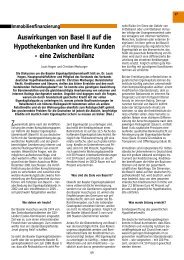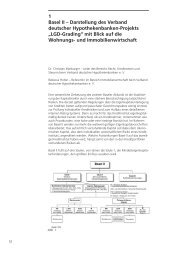Expected Loss Covered Bond Model
Expected Loss Covered Bond Model
Expected Loss Covered Bond Model
You also want an ePaper? Increase the reach of your titles
YUMPU automatically turns print PDFs into web optimized ePapers that Google loves.
Within the Moody’s EL <strong>Model</strong>, the Collateral Score plays a key role in determining the cash flow that is assumed<br />
will be received by the <strong>Covered</strong> <strong>Bond</strong>s following Issuer Default. The use and impact of Collateral Scores in<br />
Moody’s EL <strong>Model</strong> are described in Appendices C4 and C5.<br />
Refinancing the Cover Pool<br />
Following an Issuer Default, the timely repayment of principal may rely on funds being raised against the Cover<br />
Pool. The reason for this is that the duration of the assets in the Cover Pool will generally be longer than that of the<br />
<strong>Covered</strong> <strong>Bond</strong>s. In other words, the “natural” amortisation of the Cover Pool assets may not be sufficient to repay<br />
principal under the <strong>Covered</strong> <strong>Bond</strong>s.<br />
Where the “natural” amortisation of Cover Pool assets alone cannot be relied on to repay principal, Moody’s EL<br />
<strong>Model</strong> assumes that funds must be raised against the Cover Pool, most likely at a discount to the notional value of<br />
the Cover Pool. Little pricing data is available for this type of fund-raising, and accordingly, Moody’s will calculate<br />
refinancing margins based on the price history seen for similar asset pools in the securitisation and other markets.<br />
Under Moody’s EL <strong>Model</strong>, the following three key considerations are taken into account in determining the<br />
refinancing risk for any Cover Pool:<br />
• The refinancing margin that is required to refinance the Cover Pool remaining after adjustment for any<br />
write-off following Issuer Default. Refinancing margins assumed in Moody’s EL <strong>Model</strong> are described in<br />
Appendix D1, and the method for their calculation is explained in Appendix D3. Refinancing margins are<br />
also impacted by the Collateral Score, and this is discussed in Appendix C5.<br />
• The size of the Cover Pool that is required to redeem in full all <strong>Covered</strong> <strong>Bond</strong>s prior to their legal final<br />
maturity. A further description is set out in Appendix D2.<br />
• The average life of the Cover Pool that is expected at the time of refinance.<br />
A simplified example in Appendix D4 shows how the loss on the Cover Pool due to refinancing risk may be<br />
calculated, and in particular how this is impacted by the refinancing margin and average life of the Cover Pool.<br />
Market Risks<br />
Following Issuer Default, investors in <strong>Covered</strong> <strong>Bond</strong>s may be exposed to interest and currency rate risk, which<br />
may arise from the different payment promises and durations made on the Cover Pool and the <strong>Covered</strong> <strong>Bond</strong>s.<br />
Under Moody’s EL <strong>Model</strong>, the following two key considerations are taken into account in determining the interest<br />
and currency rate risks for <strong>Covered</strong> <strong>Bond</strong>s:<br />
• The level and length of exposure to these market risks. The level and length of exposure depends on the<br />
specific characteristics of the <strong>Covered</strong> <strong>Bond</strong>s and the Cover Pool backing the <strong>Covered</strong> <strong>Bond</strong>s, and in<br />
addition, the hedging arrangements in place. The main market risks to which a Cover Pool is exposed are<br />
discussed in Appendix E1, while Appendix E3 discusses how the Moody’s EL <strong>Model</strong> considers hedging<br />
arrangements. A simplified example which shows how the loss on the Cover Pool due to interest rate risk<br />
may be calculated at time of refinancing of the Cover Pool is discussed in Appendix E5.<br />
• The stress imposed by the Moody’s EL <strong>Model</strong> on any exposure to these market risks. These are<br />
discussed in Appendix E3, and the method of calculation is explained in Appendix E4.<br />
European <strong>Covered</strong> <strong>Bond</strong> Rating Methodology Moody’s Investors Service • 3

















